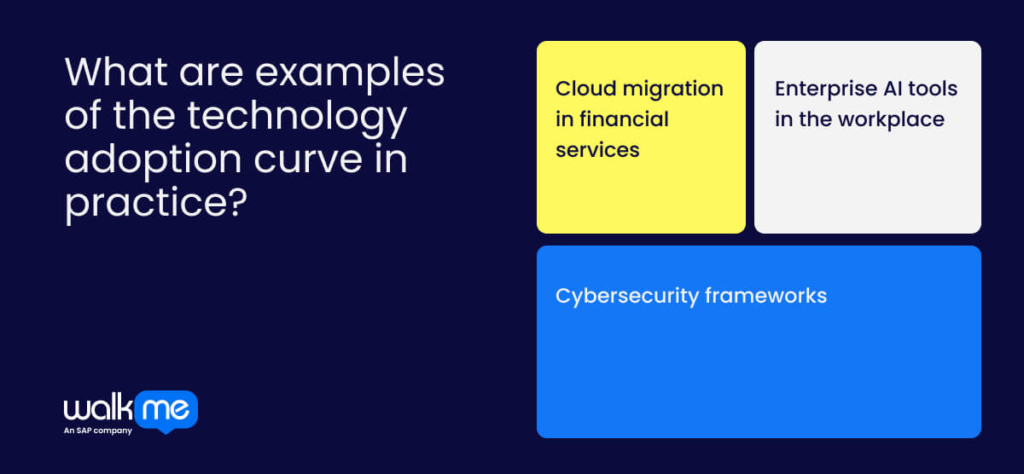The hardest part of any new software rollout isn’t the technology—it’s people’s response to change. Without a clear plan or adequate support, change management efforts can stall, damaging employee morale and slowing adoption.
Digital adoption never happens all at once. Some employees are eager to try new tools, others wait for proof, and a few only adapt when they have no alternative. These differences create friction, raising concerns about control, productivity, and trust.
The technology adoption curve provides a framework to manage this challenge. Categorizing employees into five adopter groups enables leaders to anticipate reactions, target communications, and sequence rollouts more effectively.
In this article, we’ll explain what the technology adoption curve is, why it matters for organizational change, and how to apply it with examples that improve both adoption rates and long-term employee retention.
What is the technology adoption curve?
The technology adoption curve is a model that illustrates how people adopt new products, ideas, or technologies over time. Shaped like a bell curve, it divides users into five categories: innovators, early adopters, early majority, late majority, and laggards.
Understanding these groups helps companies predict adoption rates and design targeted strategies for each stage. For example, innovators may immediately embrace advanced features, while the late majority often waits for proven results and broad acceptance.
Rooted in Everett Rogers’ Diffusion of Innovations theory, the model is especially valuable in B2B SaaS, where effective change management and employee onboarding can determine the success of a rollout. It guides product launches, marketing approaches, and long-term innovation planning.
Why is the technology adoption curve important?
The technology adoption curve illustrates how innovation spreads—and why timing is crucial. For B2B SaaS companies, this framework informs not only go-to-market strategies but also change management initiatives inside the enterprise.
From a product perspective, the Curve helps leaders align investment with customer behavior. Early adopters value advanced features and are willing to pay a premium, while the early majority looks for proven solutions at scale. Misjudging this shift—especially the “chasm” between niche adoption and mainstream use—can stall growth and undermine long-term revenue.
Internally, the technology adoption curve also supports employee morale and retention during digital transformation. By focusing first on early champions, organizations can reduce resistance, accelerate the adoption of new platforms, and avoid the high costs associated with failed rollouts.
Ultimately, the framework gives executives a strategic lens to predict adoption patterns, prioritize resources, and plan market entry. It turns uncertainty into a roadmap for sustainable growth.
What are the five stages of the technology adoption curve?

The technology adoption curve identifies five groups, each with distinct behaviors and motivations. Understanding these groups helps leaders design more effective strategies for product launches, digital adoption, and organizational change management.
1. Innovators
Innovators are the first to explore new technology. They thrive on experimentation and are motivated by curiosity rather than practicality. Engaging them means offering early access, beta programs, and transparent communication about new features. Their feedback is invaluable for refining products before a broader rollout.
2. Early Adopters
Early Adopters are visionary leaders who see the potential of new solutions. They are willing to take calculated risks if they believe a product gives them a competitive edge. Winning them over requires a clear value proposition, case studies that demonstrate the impact of problem-solving, and strong support systems. Their advocacy often influences the next stage of adopters.
3. Early Majority
The Early Majority are pragmatic and deliberate in their approach. They prefer evidence of success before making a commitment. For them, testimonials, peer references, and demonstrations of real-world benefits are critical. A seamless onboarding experience, strong reliability, and visible proof points help this group adopt with confidence.
4. Late Majority
The Late Majority are skeptical and cost-conscious. They adopt a product only after it has become mainstream. To reach them, position your solution as a safe and proven choice, supported by industry standards. Simple deployment, reliable customer support, and clear documentation reduce their hesitation.
5. Laggards
Laggards are resistant to change and only adopt when no alternatives remain. While they may not drive early growth, they still matter for complete organizational adoption. The focus here should be on stability, compliance, and continuity—demonstrating that your solution has become the industry standard and is essential for long-term success.
What are examples of the technology adoption curve in practice?

Applying the technology adoption curve helps enterprise leaders plan transformations with precision. It clarifies where different groups—employees, customers, or partners—are in their journey, and what strategies accelerate adoption at each stage.
Cloud migration in financial services
When banks migrate to cloud infrastructure, innovators and early adopters are often pilot teams eager to test performance. Their feedback uncovers compliance and security gaps before wider rollout. The early majority follows once governance frameworks are in place. By the time the late majority and laggards move, the emphasis shifts to stability, integration with legacy systems, and long-term vendor management. Without sequencing adoption this way, banks risk stalled programs or regulatory setbacks.
Enterprise AI tools in the workplace
AI copilots and automation platforms spread in waves. Innovators experiment with cutting-edge features; early adopters, often IT or marketing, prove business value. The early majority demands ROI, training, and support. Later groups require safeguards against bias, privacy, and compliance issues. CIOs who map adoption stages can set realistic timelines, reduce cultural resistance, and guide responsible scaling.
Cybersecurity frameworks
Rolling out zero-trust authentication begins with innovators in security operations. Early adopters are risk-aware teams who accept new controls. The early majority requires reassurance through awareness campaigns and measurable risk reduction. For the late majority and laggards, adoption only happens when compliance mandates make the “new way” non-negotiable.
Reduce resistance to change by utilizing the technology adoption curve methodology
By understanding the diverse needs of different user groups, from enthusiastic innovators to cautious laggards, teams can develop tailored strategies that effectively meet everyone’s needs. For instance, using the technology adoption curve model allows you to leverage early adopters as champions. Then, you can also provide extra support and proof that the late majority and laggards require to feel comfortable.
To enhance this process, companies can utilize digital adoption solutions (DAS). These tools serve as a guide within new software, providing live support and progress tracking to minimize frustration.
Beyond technology, minimizing resistance involves clear and consistent communication, engaging employees from the start to foster a sense of ownership, and recognizing individual efforts to boost employee morale.
Combining the right tools with the above strategy helps businesses build a more resilient culture, ensuring long-term success with any digital transformation.
FAQs
A technology adoption curve, also known as the technology adoption lifecycle or S-curve, illustrates how a new product, service, or idea spreads over time. It divides people into five groups based on how quickly they try new things: Innovators, Early Adopters, Early Majority, Late Majority, and Laggards. This curve helps explain how different types of users adopt a product at various stages.
The technology adoption curve helps manage workplace changes by showing how employees adopt new technologies or processes. HR and managers can utilize it to create strategies, such as leveraging early adopters as ambassadors, providing clear evidence to the late majority, and tailoring communication to each group.

